EROS CULT
Greek Name
Ερως
Transliteration
Erôs
Latin Spelling
Eros
Roman Name
Cupid
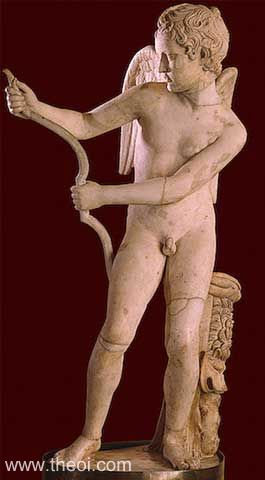
EROS was the god of love, desire and procreation.
He was typically worshipped in conjunction with the goddess Aphrodite but also had two of his own cult centres--one in the Boiotian town of Thespeia and the other at Parion (Parium) on the Hellespont.
In classical sculpture Eros was depicted as a winged child or infant, usually drawing a bow or in the company of Aphrodite.
CLASSICAL LITERATURE QUOTES
GENERAL CULT
Pausanias, Description of Greece 9. 27. 1 (trans. Jones) (Greek travelogue C2nd A.D.)
:
"Of the gods the Thespians have from the beginning honoured Eros most, and they have a very ancient image
of him, an unwrought stone. Who established among the Thespians the custom of worshipping Eros more that any
other god I do not know.
He is worshipped equally by the people of Parion on the Hellespont . . .
Pamphos and Orpheus [legendary poets] wrote hexameter verse, and composed poems on Eros, in order that they
might be among those sung by the Lykomidai to accompany the ritual. I read them after conversation with a
Torchbearer. Of these things I will make no further mention . . .
Later on Lysippos made a bronze Eros for the Thespians, and previously Praxiteles one of Pentelic marble."
CULT IN ATTICA (SOUTHERN GREECE)
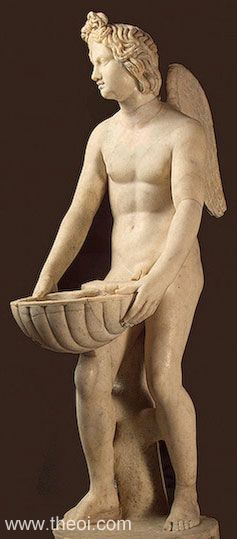
I. ATHENS (ATHENAI) Main City of Attica (Attika)
Pausanias, Description of Greece 1. 30. 1 (trans. Jones) (Greek travelogue C2nd
A.D.) :
"Before the entrance to the Akademia [outside Athens] is an altar to Eros, with an inscription that Kharmos
was the first Athenian to dedicate an altar to that god."
Plutarch, Life of Solon 1. 4 (trans. Perrin) (Greek historian C1st to C2nd A.D.)
:
"It is said that Peisistratos also had a boy lover, Kharmos, and that he dedicated the statue of Eros
(Love) in the Academy, where the runners in the sacred torch race light their torches."
CULT IN MEGARIS (SOUTHERN GREECE)
I. MEGARA Main Town of Megaris
Pausanias, Description of Greece 1. 43. 6 (trans. Jones) (Greek travelogue C2nd A.D.)
:
"There is also [statues in the temple of Aphrodite at Megara] Peitho (Persuasion) and another goddess whom
they name Paregoron (Consoler), works of Praxiteles. By Skopas are Eros (Love) and Himeros (Desire) and Pothos
(Yearning),if indeed their functions are as different as their names."
CULT IN CORINTHIA (SOUTHERN GREECE)
I. CORINTH (KORINTHOS) Main City of Corinthia (Korinthia)
Pausanias, Description of Greece 2. 5. 1 :
"On the summit of the Akrokorinthos [at Korinthos] is a temple of Aphrodite. The images are Aphrodite
armed, Helios, and Eros with bow."
CULT IN ARGOLIS (SOUTHERN GREECE)
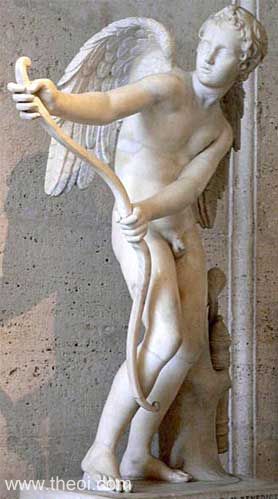
I. EPIDAURUS (EPIDAUROS) Town in Argolis
Pausanias, Description of Greece 2. 27. 3 :
"[In the sanctuary of Asklepios at Epidauros, Argos] is a picture by Pausanias representing Eros, who has
cast aside his bow and arrows, and is carrying instead of them a lyre that he has taken up."
CULT IN LACEDAEMONIA (SOUTHERN GREECE)
I. LEUCTRA (LEUKTRA) Town in Lacedaemonia (Lakedaimonia)
Pausanias, Description of Greece 3. 26. 5 :
"There is a temple and grove of Eros in Leuktra [in Lakedaimonia]. Water flows through the grove in
winter-time, but the leaves which are shaken from the trees by the wind would not be carried away by the water
even in flood."
CULT IN ELIS (SOUTHERN GREECE)
I. ELIS Main Town of Elis
Pausanias, Description of Greece 6. 23. 3 (trans. Jones) (Greek travelogue C2nd
A.D.) :
"There are also in the gymnasium [at Elis] altars of the gods, of Idaios Herakles, surnamed Parastatos
(Comrade), of Eros, of the diety called by Eleans and Athenians alike Anteros (Love Returned)."
Pausanias, Description of Greece 6. 23. 5 :
"In one of the wrestling-schools [of Elis] is a relief showing Eros (Love) and Anteros (Love Returned), as
he is called. Eros holds a palm-branch, and Anteros is trying to take the palm from him."
Pausanias, Description of Greece 6. 24. 6 :
"There is also a sanctuary to the Kharites [at Elis, Elis]; the images are of wood, with their clothes
gilded, while their faces, hands and feet are of white marble . . . the Kharites are of all deities the nearest
related to Aphrodite . . . On the right of the Kharies is an image of Eros, standing on the same pedestal."
CULT IN ACHAEA (SOUTHERN GREECE)
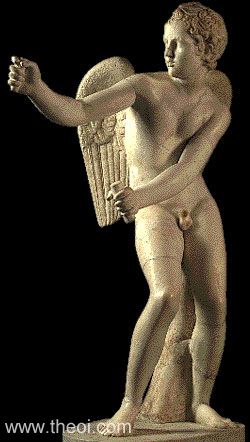
I. AEGEIRA (AIGEIRA) Town in Achaea (Akhaia)
Pausanias, Description of Greece 7. 26. 8 :
"I remember observing at Aigeira [in Akhaia] a building in which was an image of Tykhe (Fortune) carrying
the horn of Amaltheia. By her side is a winged Eros, the moral of which is that even success in love depends for
mankind on fortune rather than on beauty. Now I am in general agreement with Pindar's ode, and especially with
his making Tykhe one of the Moirai, and more powerful than her sisters."
CULT IN BOEOTIA (CENTRAL GREECE)
I. THESPEIA Town in Boeotia (Boiotia)
Strabo, Geography 9. 2. 25 (trans. Jones) (Greek geographer C1st B.C. to C1st A.D.)
:
"In earlier times Thespeia [in Boiotia] was well known because of the Eros of Praxiteles, which was
sculptured by him and dedicated by Glykera the courtesan (she had received it as a gift from the artist) to the
Thespeians, since she was a native of the place. Now in earlier times travellers would go up to Thespeia, a city
otherwise not worth seeing, to see the Eros."
Pausanias, Description of Greece 9. 27. 1 1 (trans. Jones) (Greek travelogue C2nd
A.D.) :
"Of the gods the Thespians have from the beginning honoured Eros most, and they have a very ancient image
of him, an unwrought stone. Who established among the Thespians the custom of worshipping Eros more that any
other god I do not know . . . Later on Lysippos made a bronze Eros for the Thespians, and previously Praxiteles
one of Pentelic marble."
Pausanias, Description of Greece 9. 31. 3 :
"Men too live around the grove [of the Mousai on Mt Helikon, Boiotia], and here the Thespians celebrate a
festival, and also games called the Mouseia (Of the Muses). They celebrate other games in honour of Eros,
offering prizes not only for music but also for athletic events."
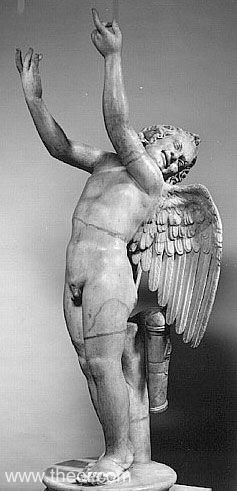
Callistratus, Descriptions 3 (trans. Fairbanks) (Greek rhetorician C4th A.D.)
:
"[A description of the statue of Eros by Praxiteles :] On the statue of Eros. My discourse desires to
interpret another sacred work of art; for it is not right for me to refuse to call the productions of art
sacred. The Eros, the workmanship of Praxiteles, was Eros himself, a boy in the bloom of youth with wings and
bow. Bronze gave expression to him, and as though giving expression to Eros as a great and dominating god, it
was itself subdued by Eros; for it could not endure to be only bronze, but it became Eros just as he was. You
might have seen the bronze losing its hardness and becoming marvelously delicate in the direction of plumpness
and, to put the matter briefly, the material proving equal to fulfilling all the obligations that were laid upon
it. It was supple but without effeminacy; and while it had the proper colour of bronze, it looked bright and
fresh; and though it was quite devoid of actual motion, it was ready to display motion; for though it was fixed
solidly on a pedestal, it deceived one into thinking that it possessed the power to fly. It was filled with joy
even to laughter, the glance from the eyes was ardent and gentle, and one could see the bronze coming under the
sway of passion and willingly receiving the representation of laughter. It stood with right hand bent toward the
head and lifting the bow with its left; and the even balance of the body's posture was modified by an
inclination toward the left, for the projecting left hip was raised so as to break the stiffness of the bronze
and produce an easy pose. The head was shaded by locks that were bright and curly and shining with the
brightness of youth. And what wonderful bronze it was! For as one looked a ruddy colour shone out from the ends
of the curls, and when one felt the hair it yielded as though soft to the touch. As I gazed on this work of art,
the belief came over me that Daidalos had indeed wrought a dancing group in motion and had bestowed sensation
upon gold, while Praxiteles had all but put intelligence into his image of Eros and had so contrived that it
should cleave the air with its wings."
Image S31.6 is a Roman marble copy of the bronze Eros of Thespeia by Lysippos. Images S31.1, S31.2 and S31.3 are variations of the same statue.
CULT IN THRACIAN HELLESPONT (NORTH-EAST OF GREECE)
I. ABYDOS Town of the Hellespont (Hellespontos)
Musaeus, Hero and Leander 39 ff (trans. Mair) (Greek poetry C5th to 6th A.D.)
:
"Often she [Hero, the priestess of Aphrodite at Abydos,] would assuage Eros too with sacrifices, together
with his Heavenly mother, fearing his quiver of flame. But still she did not escape the fire-breathing
arrows."
II. PARIUM (PARION) Town of the Hellespont
Pausanias, Description of Greece 9. 27. 1 (trans. Jones) (Greek travelogue C2nd A.D.)
:
"The Thespians [follow] the custom of worshipping Eros more that any other god I do not know. He is
worshipped equally by the people of Parion on the Hellespontos."
Copies of the famous statue of Parian Eros still exist.
SOURCES
GREEK
- Strabo, Geography - Greek Geography C1st B.C. - C1st A.D.
- Pausanias, Description of Greece - Greek Travelogue C2nd A.D.
- Plutarch, Lives - Greek Historian C1st - 2nd A.D.
- Callistratus, Descriptions - Greek Rhetoric C4th A.D.
- Musaeus, Hero and Leander - Greek Poetry C6th A.D.
BIBLIOGRAPHY
A complete bibliography of the translations quoted on this page.